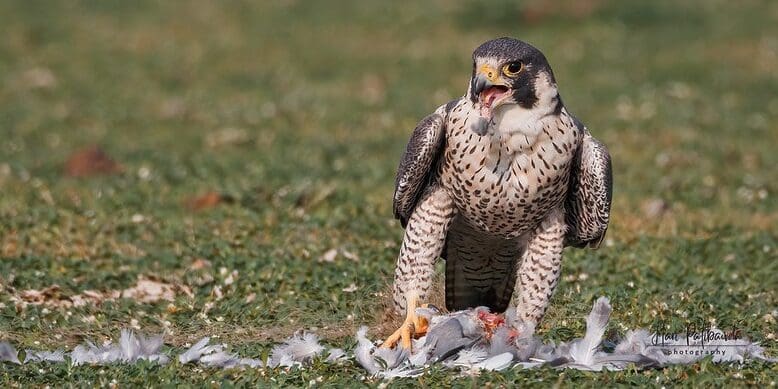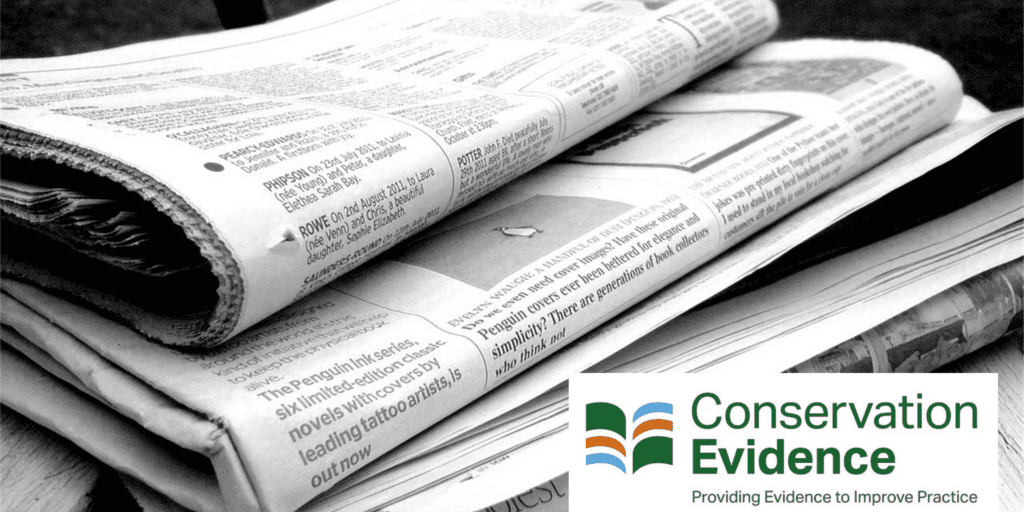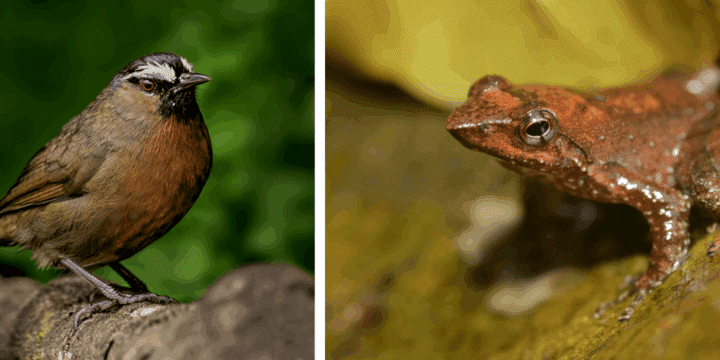The journey to evidence-based practice
“Evidence-based conservation” is a term we use a lot here at Conservation Evidence. But what does it really mean for different people or organisations working in this very diverse field? To try and understand more about how different organisations are embedding evidence in their day-to-day work, we recently hosted a workshop with our Evidence Champions: a group of organisations that have made a commitment to evidence-based practice. By coming together to share ideas and experiences (including both successes and failures!) we hope we can move forward together as a community to improve practice through better use of evidence.
In that spirit of sharing, we have brought together stories from four of our Evidence Champion organisations who are well on their way to making this transition. These are joined by 13 other practitioner organisations in our current cohort of Champions:

Tim Pankhurst – Plantlife
Tim is Regional Conservation Manager at Plantlife International
Plantlife is ramping up its commitment to Evidence-based conservation. A key part of this process is to make technical guidance available and accessible to staff. For example, those carrying out habitat and species management, species translocations, or trialling different management approaches in a rigorous experimental way so that proper lessons are learnt. This is no small effort but of course (and this is a ‘Top Tip’, even if it is obvious to some) is reliant on staff buy-in. To this end, we have set up a “Science Group”, open to all staff, where we talk about improving the ways we acquire, use and generate evidence and share ideas about how to go about it
One area we are currently looking at is how to improve the evidence-base underpinning our nature reserve management plans, without making life more burdensome for hard-pressed reserves staff. As part of this, we are also looking into how we can better gather together and disseminate what we learn from our management practices. The tools being developed by Conservation Evidence are crucial for this and, again, part of our effort is to make those tools readily available to staff and build them into our procedures. Some of these tools have been around for a while and we wish we had made ourselves aware of them earlier.
Tim’s top tip: Ensure staff have bought in to the idea of transitioning to evidence-based practices.

Pete Tomlin – Royal Society of Wildlife Trusts

Pete has worked within The Wildlife Trusts for over 10 years, initially working with Sheffield & Rotherham Wildlife Trust, delivering culture change around ecological monitoring and data. He now works with the central team at Royal Society of Wildlife Trusts (RSWT) commissioning a new data lake for the federation and working to enable Trusts to make better use of data.
The Wildlife Trusts are committed to evidence-based conservation, with several Trusts leading the way as Evidence Champions through the Conservation Evidence initiative. As a federated organisation, The Wildlife Trusts face a range of challenges when collecting, using and sharing data and evidence. For example, it is challenging to adopt standardised approaches across 47 independent charities and equally resource work such as ecological monitoring, research and data collection & analysis. Whilst some individual Trusts are excelling in this area, across the federation we do have gaps in skills linked to evidence and data, varying data maturity and difficulties in aligning the technology used by each Trust. The Wildlife Trusts have collectively committed to an ambitious Strategy 2030, and evidence and data are key to ensuring we deliver on this. To achieve our aims and fully become an evidence-led federation we have adopted a new Collective Framework on Data Research & Evidence which sets out our shared ambitions and goals in this area.
Our federated structure is also a strength as we can build on the skills, passion and innovations from around The Wildlife Trusts. Through shared projects and initiatives, led by individual or groups of Trusts, we are currently exploring how best to scale some of the great work Trusts do across the country, so that other Trusts can learn from, adopt and scale their innovations. Whilst centrally, RSWT are investing in shared technology and data platforms to enable Trusts to share data and learning easily across the federation and have a coordinating role in encouraging evidence-based conservation.
Pete’s top tips:
Lean into your successes – this is the approach we have taken when trying to scale up or champion initiatives that have popped up across the Trusts.
I wish I knew how much ongoing communication and advocacy it would take to change an organisational culture. It’s not just a case of setting up tools and processes then everything will be fine, you have to constantly champion and communicate about it.

Ben Siggery and Viki Webster – Surrey Wildlife Trust
Ben and Viki work in Surrey Wildlife Trust’s Research and Monitoring department, and are responsible for promoting academic collaborations and integrating science and evidence into all aspects of the Trust’s work.
At Surrey Wildlife Trust we are committed to evidence-based conservation, despite being in the early stages of our journey as Evidence Champions. We have focused on growing our research and monitoring team over the past few years, trying to achieve our aim of practicing conservation in line with the best available scientific evidence. Through partaking in The Wildlife Trusts’ Evidence Emergency Project, we discovered Conservation Evidence and were keen to sign up as Evidence Champions. Over the last year, we have prioritised trying to baseline our current land management approaches against Conservation Evidence. This has involved comparing actions in our reserve management plans and in-house guidance with those on the Conservation Evidence website. Whilst we found that much of what we do was supported by the evidence, the concept of using and referring to an evidence repository was quite new for a lot of the other teams we worked with. Time and resource constraints were the main issues for many of them, and this poses challenges for our research and monitoring team about how to best help other departments make use of Conservation Evidence. The next steps for us are establishing new workflows with our reserves management team to structure and formalise the testing of conservation actions.
Ben and Viki’s top tips:
Get departments across the organisation on board by explaining the benefits of evidence-based practice. It should not just feel like another thing on their to do lists. We wish we knew this when we started out. It would have been much easier to have these discussions upfront, rather than trying to catch people up a year later.
Think about what might help each department. For example, producing a template of what a test of an intervention looks like could have been useful for our land management team. Something tangible like this may have helped them get on board.

Tiago de Zoeten – Mossy Earth
Tiago is the Head of Science and Impact at Mossy Earth and is responsible for promoting scientific innovation and the use of evidence across the organisation.
As part of our journey to becoming an evidence-based organisation we have come to realise that the benefits of reviewing the evidence go beyond helping us do more of what works and less of what doesn’t. Clarity on how much uncertainty there is about the logic behind any intervention is important to define the appropriate scale of a project. If uncertainty is high, it may be crucial to carry out a small pilot intervention before scaling up. This reduces the risk of wasting resources or having unintended consequences. In these situations of uncertainty, it is more valuable to design a project that incorporates a robust experimental design, so that we can actually learn lessons for the future.
We have come up with a simple conceptual framework to capture this interaction between the strength of the evidence base and the need for a robust experimental design. This has helped us improve our own evidence use and monitoring processes, and we hope it may be helpful for others too. The idea is that we want to avoid carrying out interventions where we have weak evidence and a weak experimental design. This is what we call “guessing”. If we can become more confident about the evidence base or design the project such that it can be evaluated as an experiment then we can make sure that we are either generating impact, learning a lesson, or both. The table below is a simple way to visualize this concept.

It is not always obvious how much time should be spent reviewing the evidence for an intervention. Time is limited, so it makes sense to focus that time where it is likely to have the most impact i.e. cases where there is more uncertainty and potential consequences are higher (Chapter 8 from Transforming Conservation has lots more information on this idea). What this currently means for Mossy Earth is prioritizing interventions that we are deploying at a large and growing scale. For example, the coral restoration methods we are using in Indonesia or the assisted natural regeneration work we are doing in Portugal. Time spent assessing the nuances of the scientific evidence behind these interventions is likely to have a much greater impact than focusing on one-off interventions that address more unique and isolated problems.
Tiago’s top tips:
Is your project guessing, testing, doing or refining?
Focus limited time on the decisions that will have the biggest impact.
These stories are from just a handful of the organisations who have become Evidence Champions; seeking to learn from each other, share ideas and experiences and co-develop solutions to help embed evidence use and generation in practice for better outcomes for nature. If your organisation is interested in joining the community see here.



